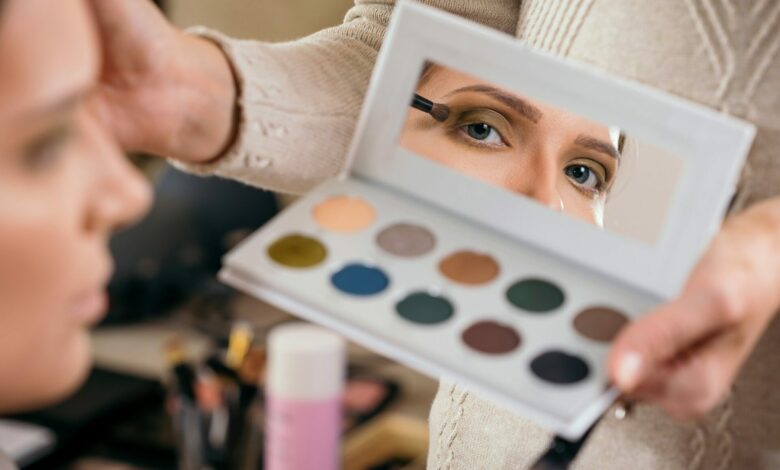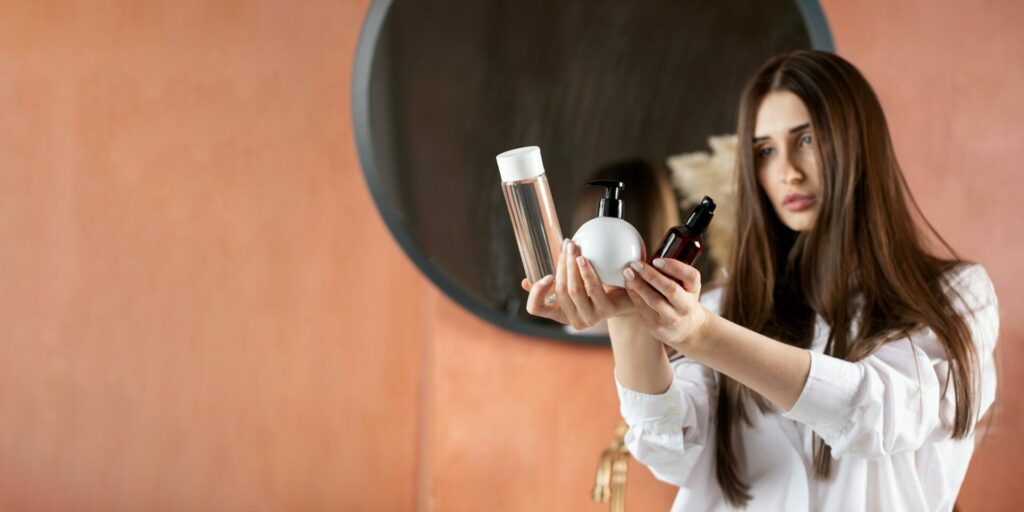
In the world of beauty, where our makeups are our most trusted allies, we don’t remember to look for enemies amongst ourselves. However, amidst the allure of vibrant pigments and the promises of radiant skin lies a dark reality: the presence of harmful makeup ingredients in these very cosmetics that nobody wants you to know about. In this article, let us embark on a journey to unmask the truth behind these harmful makeup ingredients, shedding light on the potential dangers they pose and empowering consumers to make informed decisions and choices.
Harmful Makeup Ingredients

Polyacrylamide
Found in: Facial moisturisers, anti-ageing creams, lotion and sunscreen.
It is a binding agent that holds the product together and stabilises it along with having properties such as foaming, anti-static and lubrication. It contains small amounts of acrylamide that are desired in cosmetic products. This acrylamide found in these products is a suspected carcinogen. Research suggests acrylamide is absorbed by the skin fairly quickly, particularly when applied in mixtures of oil and water. Possible side effects of this harmful makeup ingredient include skin irritation, dryness and tightness, pore clogging and allergic reactions.
UV Filters
Found in: Most sun protection cosmetics
Also known as sunscreen agents, they are added to makeup and skincare products to protect skin from harmful UV radiations from the sun. UV filters work by absorbing, reflecting, or scattering UV rays to prevent them from penetrating the skin and causing damage. Potential harmful effects of these harmful makeup ingredients include skin irritation, allergic reactions, hormonal disruptions, and phototoxicity.
Ethanolamine Compounds
Found in: Eyeliners, mascara, blush, lotion, and eye shadow.

Ethanolamine compounds, such as triethanolamine (TEA), diethanolamine (DEA), and monoethanolamine (MEA), are commonly used in cosmetics, including makeup, for various purposes, such as pH adjustment, emulsification, and as surfactants. While these compounds serve important functions in cosmetic formulations, there have been concerns raised about their potential harmful effects. The potential harmful effects include skin irritation, sensitisation, eye irritation, possible carcinogenicity and hormonal disruption.
Parabens
Found in: Moisturisers, toners, powder, concealer, eye creams, etc.
Parabens are actually several distinct chemicals with a similar molecular structure. Several are common in a wide array of cosmetic and personal care products: ethylparaben, butylparaben, isobutylparaben, isopropylparaben, methylparaben and propylparaben. Parabens are a group of synthetic preservatives commonly used in cosmetic and personal care products, including makeup, skincare, haircare, and more. They are added to these products to prevent the growth of bacteria, mould, and yeast, thus extending their shelf life. The potential harmful effects of these harmful makeup ingredients include endocrine disruption, allergic reactions and skin sensitisation.
Formaldehyde-releasing Preservatives
Found in: Foundation, concealer, eyeliners, mascara, lotions, creams and moisturisers.

Formaldehyde-releasing preservatives are a group of chemicals used in cosmetics and personal care products, including makeup, to prevent the growth of bacteria, mould, and yeast. These preservatives slowly release small amounts of formaldehyde over time to inhibit microbial growth and extend the shelf life of products. The possible harmful effects include respiratory irritation, eye irritation, skin sensitisation and potential carcinogenicity.
Carbon Black
Found in: Eyeliner, mascara, eye shadow, lipstick, brush-on-brow, and blushers.
Carbon black is the product of incomplete combustion of carbon-containing materials. Commercial carbon black, in particular, has organic contaminants such as polycyclic aromatic hydrocarbons (PAHs), which have been identified as human carcinogens. The potential health hazards of this makeup ingredient include skin irritation, potential carcinogenicity, eye inflammation, etc.
Talc
Found in: Face powder, eye shadows, blushes, and setting powders.
Talc is a naturally occurring mineral substance used in a variety of cosmetic and personal care products from baby powders to eye shadows. It is added to absorb moisture, smooth or soften products, prevent caking, and make makeup opaque. Talc can be mined from the earth or produced industrially. Some talc is contaminated with asbestos and asbestos fibres, a mineral substance linked to cancer, as a result of its close proximity to talc deposits and mining sites. It is found in baby powder, lotions, feminine hygiene products, etc. The possible health hazards of this harmful makeup ingredient include risk of asbestos contamination which could lead to possible lung diseases, ovarian cancer risk and respiratory risks.
Mercury
Found in: Skin-lightening creams, mascara, and eyeliner.
Mercury is a heavy metal that is sometimes found in certain cosmetics, particularly in skin-lightening creams, mascaras, eyeliners, and other products. While mercury has been used historically in cosmetics for its skin-whitening properties, its use is highly regulated in many countries due to its potential health risks. The potential health hazards include skin damage, systemic toxicity, etc.
Synthetic Colours
Found in: Lipsticks, lip glosses, blush, bronze, and eyeliners.
Synthetic colours are artificial colourants used in makeup and cosmetic products to enhance their appearance, imparting vibrant hues or shades. While synthetic colours serve aesthetic purposes and are widely used in the cosmetics industry, there are some potential harmful effects associated with their use. The potential harmful effects of this harmful makeup ingredient include metal contamination, endocrine disruption and carcinogenicity.
Fragrance
Found in: Body lotions, creams, soaps, foundation, powders, deodorants and lipstick.

Fragrance is defined by the FDA as a combination of chemicals that gives each perfume or cologne (including those used in other products) its distinct scent. Fragrance ingredients may be derived from petroleum or natural raw materials. The potential health hazards of this harmful makeup ingredient include neurological effects that can cause headaches, dizziness and nausea.
Alcohol
Found in: Toners, liquid foundation, concealers, facial cleansers and makeup removers.
Alcohol may be present in many categories of hair, cosmetic and hygiene products such as hair styling products, foundations, perfumes and deodorants. In cosmetics, alcohol is used for its high volatility (it disappears immediately after application), its drying, refreshing and antimicrobial properties. This harmful makeup ingredient facilitates the penetration of active ingredients into the superficial layers of the skin and promotes the deposit of ingredients on the skin or hair. The possible side effects include skin dryness and irritation, disruption of skin barrier function, increased sensitivity to UV rays and dryness in hair and scalp.
Acrylates
Found in: Eyelash adhesives, artificial nail products, eyebrow gels and mascara, facial masks and sunscreen products.
Acrylates are derived from acrylic acid and are commonly found in cosmetic nail preparations. Ethyl acrylate acts as an adhesive to apply artificial nails and eyelashes. This harmful makeup ingredient is largely found in artificial nail products. Possible harmful effects include potential carcinogenicity, developmental toxicity, cellular damage and irritation of skin and eyes.
Hydroquinone
Found in: Skin-lightening creams, facial cleansers, moisturisers and lotions.
Hydroquinone is marketed most aggressively to women of colour for its whitening ability in skin creams. In addition to its use in skin lighteners, hydroquinone is a possible impurity of tocopheryl acetate (synthetic Vitamin E) which is very common in facial and skin cleansers, facial moisturisers and hair conditioners. The possible side effects of this harmful makeup ingredient include potential carcinogenicity, organ system toxicity and respiratory tract irritation.
Mica
Found in: Eye shadows, highlighters, blushes, bronzers and face powders.

Mica is a naturally occurring mineral dust often used in makeup foundations. Workers in cosmetic manufacturing factories are at high risk of mica exposure through inhalation. They also have reflective properties, allowing for a shimmery effect in mineral foundations. The possible health effects of this harmful makeup ingredient include metal contamination, and irritation of skin and eyes.
Petrolatum and Petroleum Jelly
Found in: Lip balms, lipsticks, hand creams, moisturisers and lotions.
Petrolatum is a byproduct of petroleum refining. With a melting point close to body temperature, petrolatum softens upon application and forms a water-repellant film around the applied area, creating an effective barrier against the evaporation of the skin’s natural moisture and foreign particles or microorganisms that may cause infection. It is largely found in lotions and creams. The possible side effects of this harmful makeup ingredient are occlusive properties, and potential carcinogenicity.
Retinol and Retinol Compounds
Found in: Anti-ageing creams, serums, night creams, eye creams, body lotions and creams.
Natural vitamin A and its derivatives have important roles in human reproduction and development and in maintaining good vision and healthy skin. All-trans retinol (retinol, vitamin A) is obtained in the diet from plant or animal sources. Retinoic acid is the most active biological form of vitamin A and retinyl palmitate is the major storage form of vitamin A in the skin. In cosmetics, natural and synthetic retinol and retinol derivatives are used as skin conditioners and anti-acne agents in a variety of moisturisers, lotions and anti-aging creams. The possible health hazards include potential carcinogenicity and toxicity.
Synthetic Musks
Found in: Body lotions, sprays, body washes and gels, and hand creams.
Synthetic musks are used as fragrance ingredients in personal care and cleaning products. The most common types of musks used in consumer products are nitro-musks (e.g., musk ketone and musk xylene) and polycyclic musks (e.g., galaxolide and tonalide). Largely found in perfumes and colognes but also in soaps, body wash, etc. The possible health hazards of this harmful makeup ingredient include endocrine disruption, organ system toxicity, and bioaccumulation.
Resorcinol
Found in: Acne treatments, and skin lightening creams.

Resorcinol is used in acne and skin treatment medication to remove hard scaly or rough skin. The concentration in acne medicine is usually about two percent. When resorcinol is used as a dermatological treatment, it is likely to be applied to damaged skin, which allows more resorcinol to enter the body. Consumers are primarily exposed to this harmful makeup ingredient through cosmetic products such as hair dyes/bleaches, skin peels and treatments for a number of dermatological problems including acne and eczema. The possible health hazards include skin irritation and sensitisation and organ system toxicity.
Silica
Found in: Face powders, foundations, setting powders, primers, concealers, blushes, bronzers, and eye shadows.
Silica is a mineral commonly used in cosmetics and personal care products for its absorbent and thickening properties. It is found in face powders, foundations, primers, concealers, and setting sprays. The possible health hazards of this harmful makeup ingredient include abrasive properties, contamination and skin irritation.
Titanium Dioxide
Found in: BB Creams, CC creams, primer products, face powders, bronzer and eye shadows.
Titanium dioxide (TiO2) is used in a variety of personal care products, including sunscreens, pressed powders, and loose powders, as a UV filter or whitening agent. In lotions and creams (dermal exposure), it is not a risk for adverse health effects. However, when titanium dioxide is inhalable—as it may be when in powder form—it is considered a possible carcinogen by the International Agency for Research on Cancer. It poses no risk from skin exposure but inhalation of this makeup ingredient may lead to potential carcinogenicity.
Toluene
Found in: Eyelash adhesives, nail polishes and hair dyes.
Toluene is used in cosmetics primarily as a solvent and as a component in nail polish formulations. It helps dissolve other ingredients and gives nail polish its smooth texture and glossy finish. Toluene exposure can pose several health risks, particularly with prolonged or repeated exposure. Inhalation of toluene vapours can cause symptoms such as headaches, dizziness, nausea, and irritation of the respiratory tract. Chronic exposure to high levels of this harmful makeup ingredient may lead to many severe health effects, including damage to the central nervous system, liver, and kidneys.
Lead Acetate
Found in: Hair dyes
Lead acetate has been used as a colour additive in some hair dyes, primarily to gradually darken the colour of hair over time. It achieves this by reacting with sulphur-containing proteins in hair to form lead sulphide, which produces a darker colour. Lead is a highly toxic metal that can accumulate in the body over time, leading to serious health issues. Lead exposure has been linked to neurological, developmental, reproductive, and other systemic effects, even at low levels of exposure. Ingestion or absorption of this harmful makeup ingredient through the skin or scalp can result in lead poisoning.
P-phenylenediamine
Found in: Hair products like hair dyes.
PPD is used as a colouring agent in hair dyes because of its ability to produce a wide range of colours that are long-lasting. It is particularly effective in dark or permanent hair dyes. PPD can cause allergic reactions in some individuals, especially those with sensitive skin. Allergic reactions to this harmful makeup ingredient can range from mild skin irritation, redness, and itching to more severe symptoms such as blistering, swelling, and even anaphylaxis in rare cases. Sensitivity to PPD can develop over time with repeated exposure. To avoid that, one can consider looking for makeup with vegan makeup ingredients.
Hydrogenated Cottonseed Oil
Found in: Lip sticks, lip balms, moisturisers and lotions.

Hydrogenated cottonseed oil is commonly used in cosmetics and personal care products as an emollient, thickening agent, and texture enhancer. It helps to soften and moisturise the skin, improve the texture of products, and provide a smooth, creamy consistency. Hydrogenated cottonseed oil is generally regarded as safe for use in cosmetics and personal care products when used as directed. However, individuals with known allergies or sensitivities to cottonseed or other plant-based ingredients should exercise caution and perform a patch test before using products containing this harmful makeup ingredient.
Sulphates
Found in: Facial cleaners, cleansing oil, micellar water, foaming masks and clay masks.
Sulphates are surfactants, which means they act as cleansing agents by helping to remove dirt, oil, and debris from the skin and hair. They create lather when mixed with water, which can give a satisfying feeling of cleanliness. Sulphates have been associated with skin and scalp irritation, especially for individuals with sensitive skin, eczema, or psoriasis.
As we conclude our exploration into the world of makeup ingredients, one thing becomes abundantly clear: awareness is key to safeguarding our health and well-being. While the allure of beauty products may be enticing, it’s imperative that we scrutinise labels, educate ourselves on potential risks, and advocate for safer alternatives. By demanding transparency from cosmetics companies and embracing clean, non-toxic vegan makeup formulations, we can take proactive steps towards preserving our health while still indulging in the artistry of makeup. Together, let us strive for a beauty industry that prioritises safety, integrity, and empowerment for all.



